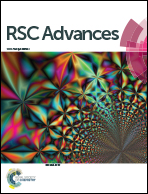Design, synthesis and biological evaluation of soluble 2,5-diketopiperazines derivatives as potential antifouling agents†
Abstract
A small library of soluble 2,5-diketopiperazine derivatives were designed, synthesized and evaluated as antifouling agents against two species of marine organisms: Balanus amphitrite and Bugula neritina by larval attachment assay. The results showed that different derivatives had different antifouling activities. Among these compounds, 3a (EC50 = 2.5 μg mL−1), 3b (EC50 = 3.2 μg mL−1) and 3d (EC50 = 1.6 μg mL−1) had strong activities, and 2d (EC50 = 20.5 μg mL−1), 3l (EC50 = 25.0 μg mL−1) and 3m (EC50 = 18.5 μg mL−1) had moderate activities against Balanus amphitrite, but other compounds had no activities. Differently, compounds 3d (EC50 = 3.1 μg mL−1) and 3i (EC50 = 2.3 μg mL−1) exhibited strong activities, and 3a (EC50 = 11.3 μg mL−1) and 3c (EC50 = 17.2 μg mL−1) showed moderate activities against Bugula neritina, whereas other compounds had no activities. All of the active compounds had stronger antifouling activities than those of the natural product cyclo-(L-Phe-L-Pro). Compound 3d could be a new template molecule for further development as an antifouling agent because of its strong inhibitory activities against both species of fouling organisms with low or no toxicity to the environment.


 Please wait while we load your content...
Please wait while we load your content...